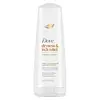What's inside
What's inside
 Key Ingredients
Key Ingredients

 Benefits
Benefits

 Concerns
Concerns

 Ingredients Side-by-side
Ingredients Side-by-side

Zinc Pyrithione 0.5%
AntiseborrhoeicWater
Skin ConditioningCetearyl Alcohol
EmollientCyclopentasiloxane
EmollientStearamidopropyl Dimethylamine
EmulsifyingDimethiconol
EmollientBehentrimonium Chloride
PreservativeCocos Nucifera Oil
MaskingButyrospermum Parkii Butter
Skin ConditioningTocopheryl Acetate
AntioxidantHelianthus Annuus Seed Oil
EmollientParfum
MaskingDipropylene Glycol
HumectantLactic Acid
BufferingDMDM Hydantoin
PreservativeZinc Sulfate
AntimicrobialSodium Chloride
MaskingTea-Dodecylbenzenesulfonate
CleansingGlycerin
HumectantButylene Glycol
HumectantIodopropynyl Butylcarbamate
PreservativePEG-150 Distearate
EmulsifyingZinc Pyrithione 0.5%, Water, Cetearyl Alcohol, Cyclopentasiloxane, Stearamidopropyl Dimethylamine, Dimethiconol, Behentrimonium Chloride, Cocos Nucifera Oil, Butyrospermum Parkii Butter, Tocopheryl Acetate, Helianthus Annuus Seed Oil, Parfum, Dipropylene Glycol, Lactic Acid, DMDM Hydantoin, Zinc Sulfate, Sodium Chloride, Tea-Dodecylbenzenesulfonate, Glycerin, Butylene Glycol, Iodopropynyl Butylcarbamate, PEG-150 Distearate
Water
Skin ConditioningBehentrimonium Chloride
PreservativeCetyl Alcohol
EmollientPropanediol
SolventGlycerin
HumectantPolyquaternium-37
C13-15 Alkane
SolventBis-Aminopropyl Diglycol Dimaleate
Skin ConditioningPhenoxyethanol
PreservativeParfum
MaskingGuar Hydroxypropyltrimonium Chloride
Skin ConditioningLecithin
EmollientIsopropyl Alcohol
SolventPolyester-11
Skin ConditioningSclerotium Gum
Emulsion StabilisingChlorphenesin
AntimicrobialGlycine Soja Seed Extract
Skin ConditioningTriheptanoin
Skin ConditioningPanthenol
Skin ConditioningStearamidopropyl Dimethylamine
EmulsifyingCoco-Caprylate/Caprate
EmollientEthylhexylglycerin
Skin ConditioningPolyimide-1
Oryza Sativa Bran Extract
Skin ConditioningNiacinamide
SmoothingVitis Vinifera Seed Oil
Emollient1,2-Hexanediol
Skin ConditioningSarcosine
Skin ConditioningHydrolyzed Quinoa
Skin ConditioningCitric Acid
BufferingDilinoleic Acid/Butanediol Copolymer
Pisum Sativum Seed Extract
Skin ConditioningPropylene Glycol
HumectantHelianthus Annuus Extract
EmollientTrisodium Ethylenediamine Disuccinate
Hexyl Cinnamal
PerfumingLimonene
PerfumingRosmarinus Officinalis Leaf Extract
AntimicrobialTocopherol
AntioxidantSodium Hyaluronate
HumectantEthyl Lauroyl Arginate Hcl
Skin ConditioningArginine
MaskingTetrasodium Glutamate Diacetate
Sodium Benzoate
MaskingBenzyl Alcohol
PerfumingCastor Oil/Ipdi Copolymer
Potassium Sorbate
PreservativeCaesalpinia Spinosa Fruit Extract
Skin ProtectingHelianthus Annuus Sprout Extract
Skin ConditioningSodium Hydroxide
BufferingAmaranthus Caudatus Seed Extract
Skin ConditioningJojoba Esters
EmollientHelianthus Annuus Seed Wax
Skin ConditioningPolyglycerin-3
HumectantCI 19140
Cosmetic ColorantCI 15985
Cosmetic ColorantWater, Behentrimonium Chloride, Cetyl Alcohol, Propanediol, Glycerin, Polyquaternium-37, C13-15 Alkane, Bis-Aminopropyl Diglycol Dimaleate, Phenoxyethanol, Parfum, Guar Hydroxypropyltrimonium Chloride, Lecithin, Isopropyl Alcohol, Polyester-11, Sclerotium Gum, Chlorphenesin, Glycine Soja Seed Extract, Triheptanoin, Panthenol, Stearamidopropyl Dimethylamine, Coco-Caprylate/Caprate, Ethylhexylglycerin, Polyimide-1, Oryza Sativa Bran Extract, Niacinamide, Vitis Vinifera Seed Oil, 1,2-Hexanediol, Sarcosine, Hydrolyzed Quinoa, Citric Acid, Dilinoleic Acid/Butanediol Copolymer, Pisum Sativum Seed Extract, Propylene Glycol, Helianthus Annuus Extract, Trisodium Ethylenediamine Disuccinate, Hexyl Cinnamal, Limonene, Rosmarinus Officinalis Leaf Extract, Tocopherol, Sodium Hyaluronate, Ethyl Lauroyl Arginate Hcl, Arginine, Tetrasodium Glutamate Diacetate, Sodium Benzoate, Benzyl Alcohol, Castor Oil/Ipdi Copolymer, Potassium Sorbate, Caesalpinia Spinosa Fruit Extract, Helianthus Annuus Sprout Extract, Sodium Hydroxide, Amaranthus Caudatus Seed Extract, Jojoba Esters, Helianthus Annuus Seed Wax, Polyglycerin-3, CI 19140, CI 15985
Ingredients Explained
These ingredients are found in both products.
Ingredients higher up in an ingredient list are typically present in a larger amount.
This ingredient is a preservative and often used for it's anti-static properties. You'll most likely see this ingredient in hair conditioners.
It does not cause irritation or sensitization in leave-on products at 1-5%.
Glycerin is already naturally found in your skin. It helps moisturize and protect your skin.
A study from 2016 found glycerin to be more effective as a humectant than AHAs and hyaluronic acid.
As a humectant, it helps the skin stay hydrated by pulling moisture to your skin. The low molecular weight of glycerin allows it to pull moisture into the deeper layers of your skin.
Hydrated skin improves your skin barrier; Your skin barrier helps protect against irritants and bacteria.
Glycerin has also been found to have antimicrobial and antiviral properties. Due to these properties, glycerin is often used in wound and burn treatments.
In cosmetics, glycerin is usually derived from plants such as soybean or palm. However, it can also be sourced from animals, such as tallow or animal fat.
This ingredient is organic, colorless, odorless, and non-toxic.
Glycerin is the name for this ingredient in American English. British English uses Glycerol/Glycerine.
Learn more about GlycerinParfum is a catch-all term for an ingredient or more that is used to give a scent to products.
Also called "fragrance", this ingredient can be a blend of hundreds of chemicals or plant oils. This means every product with "fragrance" or "parfum" in the ingredients list is a different mixture.
For instance, Habanolide is a proprietary trade name for a specific aroma chemical. When used as a fragrance ingredient in cosmetics, most aroma chemicals fall under the broad labeling category of “FRAGRANCE” or “PARFUM” according to EU and US regulations.
The term 'parfum' or 'fragrance' is not regulated in many countries. In many cases, it is up to the brand to define this term.
For instance, many brands choose to label themselves as "fragrance-free" because they are not using synthetic fragrances. However, their products may still contain ingredients such as essential oils that are considered a fragrance by INCI standards.
One example is Calendula flower extract. Calendula is an essential oil that still imparts a scent or 'fragrance'.
Depending on the blend, the ingredients in the mixture can cause allergies and sensitivities on the skin. Some ingredients that are known EU allergens include linalool and citronellol.
Parfum can also be used to mask or cover an unpleasant scent.
The bottom line is: not all fragrances/parfum/ingredients are created equally. If you are worried about fragrances, we recommend taking a closer look at an ingredient. And of course, we always recommend speaking with a professional.
Learn more about ParfumWe don't have a description for Stearamidopropyl Dimethylamine yet.
Water. It's the most common cosmetic ingredient of all. You'll usually see it at the top of ingredient lists, meaning that it makes up the largest part of the product.
So why is it so popular? Water most often acts as a solvent - this means that it helps dissolve other ingredients into the formulation.
You'll also recognize water as that liquid we all need to stay alive. If you see this, drink a glass of water. Stay hydrated!
Learn more about Water